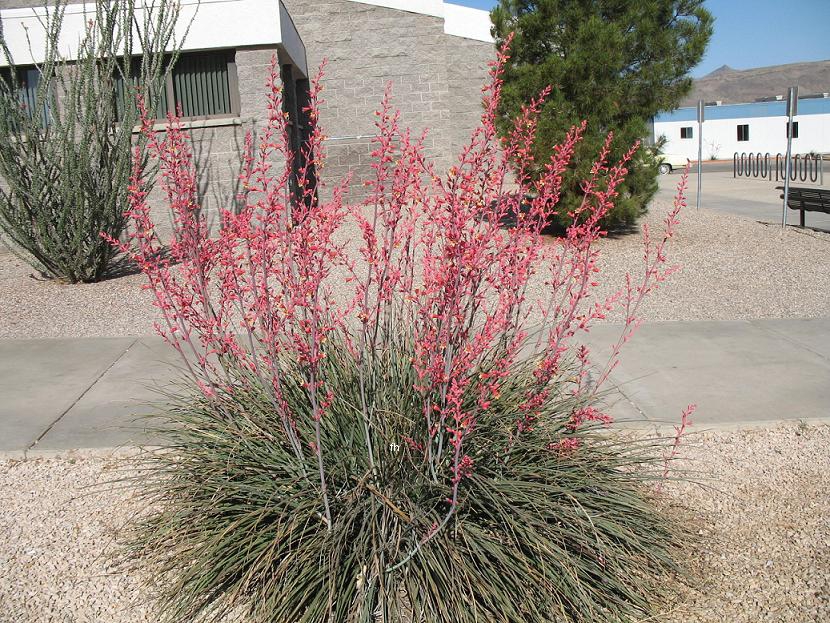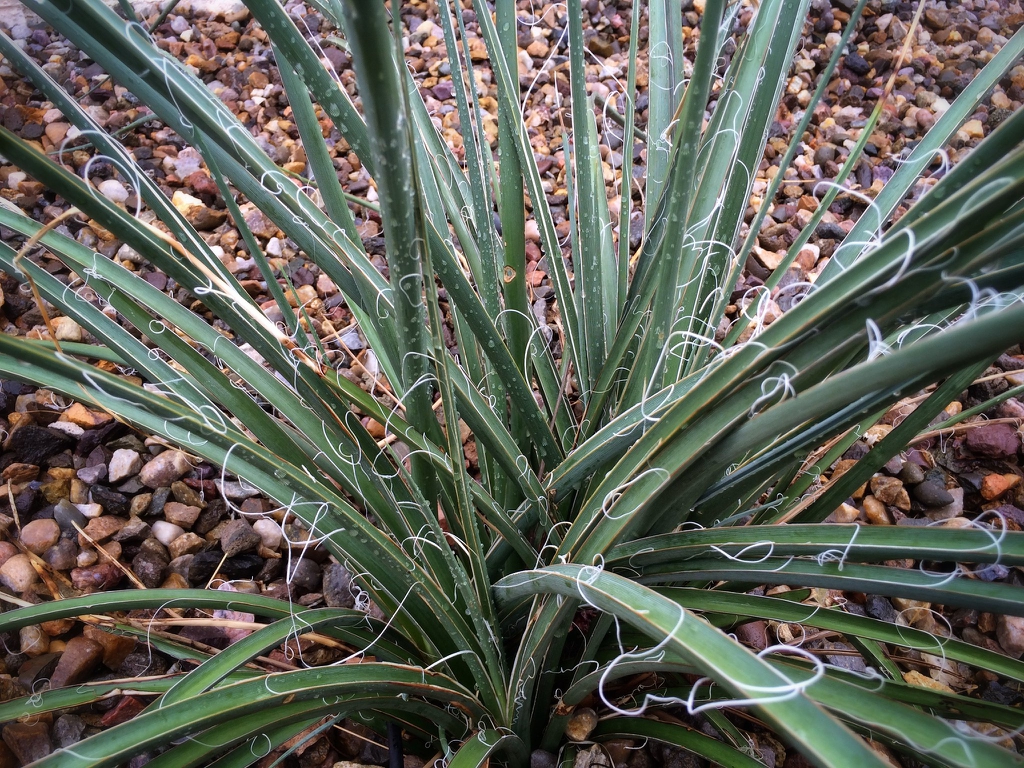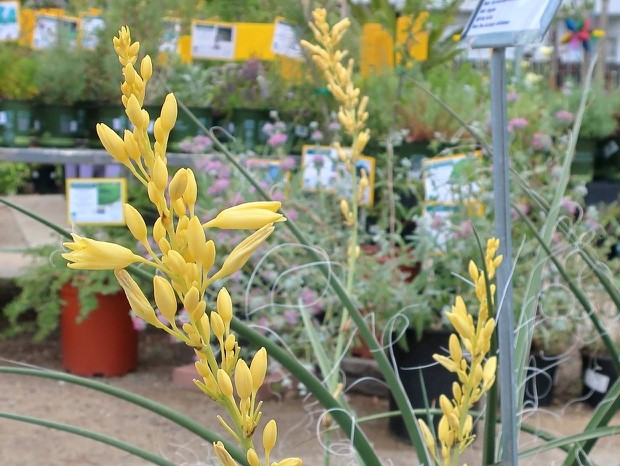 Red Yucca: Colorful and Drought Tolerant - June 30, 2021 Jeff Schalau, Agent, Agriculture & Natural Resources University of Arizona Cooperative Extension, Yavapai County Red yucca (Hesperaloe parviflora) is one of the best performing landscape succulents for the low to middle elevations of Arizona. It is a native of the Chihuahuan desert in southwestern Texas and Coahuila, Mexico making it very fit for our local climate/ environment. Better yet, once established, they are virtually maintenance free. The name Hesperaloe loosely means “western aloe” with the combination the Greek word 'Hesperis' meaning "of the evening" or "western" with "aloe" in reference to this plant being found in the North America (in the west) and superficially looking like plants in the genus Aloe. By the way, true aloes are from the old world (southern Africa, Madagascar, Jordan, the Arabian Peninsula, and various islands in the Indian Ocean). Red yucca somewhat resembles true yucca with linear leaves arising from the base and flower stalks rising above the leaves. Red yucca, however, produces several pups (new plants formed adjacent to the parent plant) which, over time, causes an ever-enlarging plant base. The leaves are generally soft and do not have sharp points at their tips and are about 1 ˝ to 2 feet long. The leaves also have handsome filaments along the leaf margins which add interest and texture. Mature plants are often about 3 feet across. The "red" in red yucca refers to the flower color. This can be misleading because there is also a yellow flowered variety available. Both are well suited. Red yucca produces several flower stalks each year, having abundant tubular flowers that bloom in spring and extend well into summer. It should be no surprise that hummingbirds are attracted to its flowers. The flower stalks can grow up to 9 feet high, but most I've seen are 3-5 feet high. A brighter red-flowered cultivar of red yucca has been selected and is for sale under the name Hesperaloe parviflora ‘Perpa’ Brakelights. Yellow flowered cultivars are also available. Red yucca loves the heat and is ideally suited to low and mid-elevations of Yavapai County. It can tolerate cold temperatures down to -20 degrees F. It makes an excellent accent plant or specimen container plant. Plant red yucca in full sun where it has room to grow without needing to be trimmed back. Nothing is worse than seeing one of these plants mowed, or worse yet, shredded by a weed eater. So, if you do not want to brush up against it, position the plants 2 to 3 feet away from sidewalks, walkways, or driveways. After planting from a nursery container, provide ample irrigation for the first year taking care not to over water. After the first year, they should do nicely on native rainfall or with infrequent irrigation during extended droughts. Infrequent irrigation will enhance flower production and plant vigor during times of drought. Maintenance is easy. On established plants, the older leaves eventually will die and lay on the ground. These can be cut off individually to create a neater appearance. This and removing dead flower stalks are the only maintenance practices needed. Red yuccas are drought adapted plants and should be planted in conjunction with plant having similar irrigation requirements. They are equally attractive when planted with cacti and succulents or with leafy plants such as Mexican primrose, brittlebush, Penstemon, or annual wildflowers. Native grasses will also compliment plantings of red yucca. A close relative of red yucca, giant Hesperaloe (Hesperaloe funifera) is a larger species that has made its way into the landscape palette. Giant Hesperaloe has stiff, broad, lime green leaves with coarse white fibers along the margins. It is a very large plant reaching a height and diameter of six feet. In the summer it blooms, sending up a 12-15 foot tall flower spike of creamy white flowers. Like red yucca, giant Hesperaloe should be planted in full sun and well-drained soil. Giant Hesperaloe can tolerate temperatures down to -10 degrees F. Mountain States Wholesale Nursery in Glendale, Arizona has worked with these plants extensively - they selected and patented the ‘Brakelights’ cultivar as well as a hybrid between Hesperaloe parviflora and Hesperaloe funifera called ‘Pink Parade’. I have included additional resources and photos below. You can follow the Backyard Gardener on Twitter – use the link on the BYG website. If you have other gardening questions, email the Master Gardener Help Desk in Prescott (prescottmg@gmail.com) or Camp Verde (verdevalleymg@gmail.com) and be sure to include your name, location, and phone number. Find past Backyard Gardener columns or provide feedback at the Backyard Gardener web site: https://cals.arizona.edu/yavapai/anr/hort/byg/. Images  Red yucca (Hesperaloe parviflora) is a handsome drought-tolerant plant for low and mid-elevation sites in Arizona (Form in bloom, Fritz Hochstatter, CC BY-SA 3.0).
Red yucca (Hesperaloe parviflora) is a handsome drought-tolerant plant for low and mid-elevation sites in Arizona (Form in bloom, Fritz Hochstatter, CC BY-SA 3.0). Red yucca leaves are soft and freindly to humans and also have attractive filaments alon the margins (Form, Jordan Meeter, CC-BY-SA 2.0).
Red yucca leaves are soft and freindly to humans and also have attractive filaments alon the margins (Form, Jordan Meeter, CC-BY-SA 2.0). Red yucca flowers bloom through the summer months (Close up of flower, Fritz Hochstatter, CC BY-SA 3.0).
Red yucca flowers bloom through the summer months (Close up of flower, Fritz Hochstatter, CC BY-SA 3.0). Some red yucca flowers are yellow. This cultivar is called 'Buttercup' ('Buttercup' flower cultivar413, CC BY 2.0).
Some red yucca flowers are yellow. This cultivar is called 'Buttercup' ('Buttercup' flower cultivar413, CC BY 2.0).Additional Resources Hesperaloe parviflora, North Carolina State University Cooperative Extension plants.ces.ncsu.edu/plants/hesperaloe-parviflora/ Redflower False Yucca, USDA PLANTS Database plants.usda.gov/home/plantProfile?symbol=HEPA8 Red Yucca (Hesperaloe parviflora) Use in Utah, Utah State University Extension digitalcommons.usu.edu/cgi/viewcontent.cgi?article=2669&context=extension_curall |